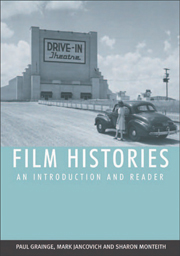Book contents
- Frontmatter
- Contents
- Preface
- Part I Film History from its Origins to 1945
- 1 The Emergence of Cinema
- 2 Organising Early Film Audiences
- 3 Nationalism, Trade and Market Domination
- 4 Establishing Classical Norms
- 5 The Age of the Dream Palace and the Rise of the Star System
- 6 Competing with Hollywood: National Film Industries outside Hollywood
- 7 The Rise of the Studios and the Coming of Sound
- 8 Realism, Nationalism and ‘Film Culture’
- 9 Adjustment, Depression and Regulation
- 10 Totalitarianism, Dictatorship and Propaganda
- 11 The Common People, Historical Drama and Preparations for War
- 12 Wartime, Unity and Alienation
- Part II Film History from 1946 to the Present
- Bibliography
- Copyright Acknowledgements
- Index
12 - Wartime, Unity and Alienation
from Part I - Film History from its Origins to 1945
Published online by Cambridge University Press: 05 August 2013
- Frontmatter
- Contents
- Preface
- Part I Film History from its Origins to 1945
- 1 The Emergence of Cinema
- 2 Organising Early Film Audiences
- 3 Nationalism, Trade and Market Domination
- 4 Establishing Classical Norms
- 5 The Age of the Dream Palace and the Rise of the Star System
- 6 Competing with Hollywood: National Film Industries outside Hollywood
- 7 The Rise of the Studios and the Coming of Sound
- 8 Realism, Nationalism and ‘Film Culture’
- 9 Adjustment, Depression and Regulation
- 10 Totalitarianism, Dictatorship and Propaganda
- 11 The Common People, Historical Drama and Preparations for War
- 12 Wartime, Unity and Alienation
- Part II Film History from 1946 to the Present
- Bibliography
- Copyright Acknowledgements
- Index
Summary
With the bombing of Pearl Harbor by the Japanese in 1941, the United States entered into the Second World War. In the process, the film industry and its personnel were recruited for the war effort. Directors such as Frank Capra and John Ford were conscripted into the armed forces where they made a series of documentaries that supported US involvement. Capra, for example, made a seven-part documentary series, Why We Fight (1943), that was shown to all recruits to the armed forces. The series used existing footage produced by both the Allies and the Axis powers to establish the case for US involvement. Ford, by contrast, made The Battle of Midway (1942), in which he used 16mm cameras to capture the action and received both a medal for injuries sustained during the conflict and an Oscar for best documentary.
Hollywood was also enlisted in other ways. The Office of War Information (OWI) worked with the film industry to mobilise support for the war and maintain morale during it. In the process, a whole host of films sought to illustrate the dangers of the menace posed by the Axis powers. For example, Basil Rathbone played Sherlock Holmes in a series of films during the war years, many of which featured diabolical Nazi plots that were foiled by the brilliant detective. The OWI was particularly concerned to create a sense of national unity in which internal tensions were downplayed and the United States was presented as a diverse but unified country.
- Type
- Chapter
- Information
- Film HistoriesAn Introduction and Reader, pp. 256 - 276Publisher: Edinburgh University PressPrint publication year: 2007



